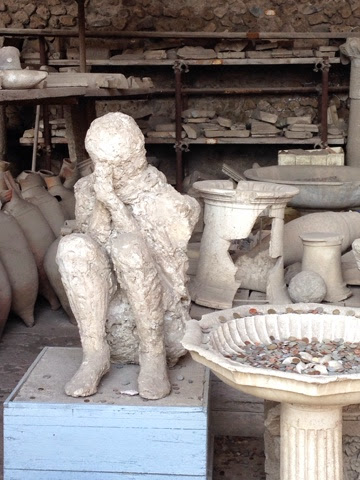Our
Italian guide spoke rapid English. He
struggled with the pronunciation of earthquake because he felt impelled to end
each word with a vowel. He called the
natural phenomenon a “hurt-a-quake.” We
were touring the remains of Pompeii which was destroyed by a volcanic eruption
that covered the entire village in ash.
There
was an old brothel (decommissioned, of course) where the ancient Pompeiians
went to pass the time. Just like today,
I bet there wasn’t much to do. The
whorehouse was recognizable by a phallic protrusion hanging above the
doorway. Even back then, subliminal advertising
was effectively bringing in customers.
Inside
the building, old paintings showed couples in various positions of copulation. Perhaps they were instructions for beginners. I can’t imagine the beds were very
comfortable, and I’m sure the repeat customers left with a persistent itch.
At
the end of the tour, there were human plasters on display. The ash solidified and encased their corpses,
frozen in their final postures. A
pregnant woman sprawled out on the ground and breathed through the gaps in her
fingers before she suffocated. Another
figure was sitting with his knees near his chest. His hands were clasped in prayer.
Aggressive
tourists were jockeying for a better position to photograph his remains. Looking through camera lenses often makes us
lose our subjectivity and sometimes our morals.
Although I was slightly disturbed by the disrespect for the dead, I,
too, pushed my way toward the front to capture an ironic image of a dead man
sitting next to a fountain filled with gold coins.
I
bet that man never could have imagined his bodily remains would be such a
money-maker on display. His thoughts
were too consumed with the afterlife.
Maybe he was worried about all those trips to the brothel. How would he be judged by his god?
Surely
he could never conceive of such a consumerist life after death. But now that man was making more tips than
the gypsies begging in the streets.
Tragedy makes for a profitable business eventually. It’s sad to think some towns are more notable
after they’ve been decimated, but repulsive sites are equally attractive for
their extreme nature.
There
are two tragedies in Pompeii. The first
obviously being the volcanic eruption.
The second and more relevant is the outrageously priced lunches. Aaron bought a small salad for four euros,
but I wanted something more substantial.
A young, bearded Italian cook caught my eye and immediately started
persuading me to buy his food.
Innocent
browsing is impossible here. I always
feel coerced into making decisions to avoid feeling guilty. The man pointed to lasagna, rigatoni, and
gnocchi in long pans behind a glass display.
The mentioning of gnocchi caught my attention, so I inquired about the price. Its ridiculousness was on par with the rest
of the stands nearby, so I had no choice but to pay up.
Besides,
I had already locked eyes with the vendor and wasted his time conversing in
broken, simpleton English that consists of pointing to things and grunting, “How
much?” If I backed out at this point,
undoubtedly, he would’ve cursed me in his language. He may have implored me to engage in
bestiality with a local farm animal, and I, ignorant to his voodoo, would have
thanked him because I didn’t know how to apologize in Italian.
So
I chose the gnocchi and watched him inexpertly spoon the pasta into a
bowl. His tiny utensil necessitated
several trips to build a full portion.
The pasta was not near a heat source that I could identify, so I wondered
how he was going to warm it up.
Fortunately,
my question was soon answered, but, unfortunately, the solution was a
microwave. So much for authentic Italian
cuisine, I thought. After tentatively taking a bite of lukewarm gnocchi, I concluded
that Pompeii was struck by a third tragedy.
Not only did its citizens burn to death or suffocate from inhaling a
giant cloud of volcanic ash, the present food is overpriced, and the quality is worse than the grub
served at my high-school cafeteria. Is
this what the people of Pompeii died for?
Mediocre pasta?

No comments:
Post a Comment